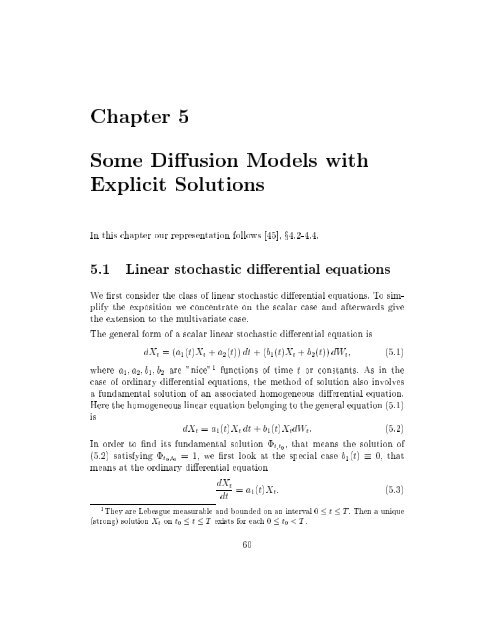Estimation in Financial Models - RiskLab
Estimation in Financial Models - RiskLab
Estimation in Financial Models - RiskLab
You also want an ePaper? Increase the reach of your titles
YUMPU automatically turns print PDFs into web optimized ePapers that Google loves.
Chapter 5<br />
Some Diusion <strong>Models</strong> with<br />
Explicit Solutions<br />
In this chapter our representation follows [45], x4.2-4.4.<br />
5.1 L<strong>in</strong>ear stochastic dierential equations<br />
We rst consider the class of l<strong>in</strong>ear stochastic dierential equations. To simplify<br />
the exposition we concentrate on the scalar case and afterwards give<br />
the extension to the multivariate case.<br />
The general form of a scalar l<strong>in</strong>ear stochastic dierential equation is<br />
dX t =(a 1 (t)X t + a 2 (t)) dt +(b 1 (t)X t + b 2 (t)) dW t ; (5.1)<br />
where a 1 ;a 2 ;b 1 ;b 2 are "nice" 1 functions of time t or constants. As <strong>in</strong> the<br />
case of ord<strong>in</strong>ary dierential equations, the method of solution also <strong>in</strong>volves<br />
a fundamental solution of an associated homogeneous dierential equation.<br />
Here the homogeneous l<strong>in</strong>ear equation belong<strong>in</strong>g to the general equation (5.1)<br />
is<br />
dX t = a 1 (t)X t dt + b 1 (t)X t dW t : (5.2)<br />
In order to nd its fundamental solution t;t0 , that means the solution of<br />
(5.2) satisfy<strong>in</strong>g t0 ;t 0<br />
= 1, we rst look at the special case b 1 (t) 0, that<br />
means at the ord<strong>in</strong>ary dierential equation<br />
dX t<br />
dt<br />
= a 1 (t)X t : (5.3)<br />
1 They are Lebesgue measurable and bounded on an <strong>in</strong>terval 0 t T . Then a unique<br />
(strong) solution X t on t 0 t T exists for each 0 t 0
















